CPLC’s BESO Program Teaches International Prep Academy Students About DNA…in Spanish

Lina Flores helps IPA 3rd graders program their Dash robot.
June 4, 2019
Navigate a mouse robot through a maze; program a Dash robot; make a DNA model with candy; experience DNA origami: these are some fun STEM activities 60 third grade students from Champaign’s International Prep Academy (IPA) got to do during a May 16th field trip to campus as part of the BESO (Bilingual Engineering and Science Outreach) program. Sponsored by the Center for the Physics of Living Cells (CPLC), the spring 2019 program featured DNA-related hands-on activities in the school, capped off by a visit to NCSA where students rotated through several additional STEM activities around the main theme for the outreach–DNA. But what was especially unique about the program was that most of the activities were conducted in Spanish.
According to Sharlene Denos, CPLC’s Associate Director for Education and Inclusivity, the crux of the BESO program was having CPLC’s native-Spanish-speaking scientists go into IPA’s classrooms during spring 2019 to do STEM activities with the students in Spanish, supported by English-speaking scientists. So in addition to hearing about science in their native language, the youngsters were also seeing Hispanic scientists and college students who served as role models for the kids. The pièce de résistance of program was the May 16th visit to campus, where a number of Spanish-speaking CPLC scientists and students also led activities in Spanish. Yann Chemla, the director of CPLC, shares why this emphasis of BESO is so important:
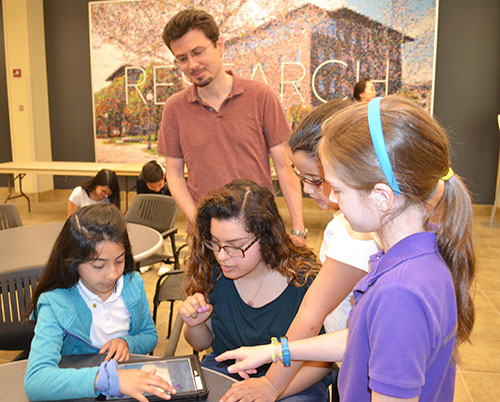 Yann Chemla (center back) watches Lina Flores teach IPA students how to program their Dash robot.
Yann Chemla (center back) watches Lina Flores teach IPA students how to program their Dash robot. “Well, one of the things that we want to do,” he says, “is make sure that we engage groups of people to do science and get them excited about science, particularly populations that are underserved. And so this is a program where we're teaching about science in Spanish. And I think that's a really good way of engaging people at that age, in their own native tongue, to get them excited about science.”
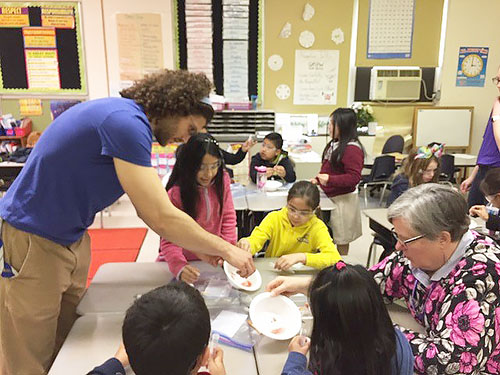
Luis Astacio works with IPA students extracting DNA from strawberries. (Image courtesy of Sharlene Denos.)
Luis Miguel de Jesús Astacio a Physics Ph.D. student who helped lead the extracting-DNA-from-strawberries outreach activity at IPA, sees BESO not just as an educational tool, but also as a method of effecting social reform. “Educating others is, by its very nature, a political act, and true social activism starts in the classrooms,” he shares. Believing that students’ “self-expectations are linked to how they see themselves in relation to others,” he hopes that sharing science concepts in Spanish with a Puerto Rican grad student will enable the students to “project themselves in a similar position. We want the kids to realize that science is a field accessible to all, not just a sub-population, and that they should feel free to pursue any interests in science if they so desire.”
The second goal of the program was to share about research going on at CPLC. According to Chemla, one of the Center’s missions is to “spread science, not just to scientists, but also to everyone in the public.” So BESO is one of several Center activities targeting all age groups, from K–12 to senior citizens. “So that's an important part of our mission is to make sure that we communicate our science to everyone and the importance of what we do.”
Denos shares why CPLC is impelementing the BESO project. “We have an express charge from the NSF (National Science Foundation) to broaden participation in science,” she explains. “Basically what that means is making a deliberate effort to reach out and include groups that were previously excluded from the pursuit of science and engineering.”

Sharlene Denos, CPLC’s Associate Director for Education and Inclusivity.
For instance, in physics, that would include women and girls; certain ethnic and racial groups such as Latinos, African Americans, and American Indians; as well as persons with disabilities. “So it's really broadly speaking trying to think about the history of exclusion within the sciences (and especially physics, because we're funded by physics)," she adds, "and trying to sort of undo that history and, going forward, to try to encourage students from a wide variety of backgrounds and experiences to engage in science.”
Even more important than rectifying historical exclusions, Denos says, is that physics needs the creativity and diversity of thought that people from these groups represent.
“Because we need the talent,” she explains, indicating that with the serious problems our society is facing, we don't know where the next solution might come from. “So we really need these kids' minds. We need their ideas. We need them in science. So that's really important to the work that we do, that educational and outreach mission."
Astacio shares that he too hopes to increase diversity in the sciences. "My personal desire is that these lessons spark the unrelenting flame of scientific curiosity in some of the kids. Science and academia in the USA are in dire need of greater diversity and kids like them will help alleviate this issue."
Regarding the program's theme—DNA—the goal was to not only share how it's important in giving hereditary traits, but also how scientists study it using experimental and also computational techniques. According to Chemla, that’s exactly what some of CPLC’s researchers do in their labs. So the activities both in the classrooms and for the campus visit addressed DNA plus several computational techniques.

IPA 3rd graders watch as their mouse robot navigates through their maze.
For two of the May 16th activities, students learned to do some very rudimentary programming. For example, in the “Code and Go Robot Mouse” activity, students used blocks to build a maze, then programmed their mouse to navigate it. Using little cards with pictorial instructions (“go straight,” “turn left,” or “turn right”), they mapped out the mouse’s path, then programmed it into the robot by pressing its buttons in consecutive order. Through trial and error, they tested their plan, having the mouse navigate the maze until it hit a snag. Then they would revise the instructions, reprogram them into the mouse, and try again. In another activity, students also got to do a bit more advanced programming, using laptops to program little Dash robots to do various movements.
In the third session, kids built DNA models using gummy bears and licorice, and also got to examine some DNA origami.
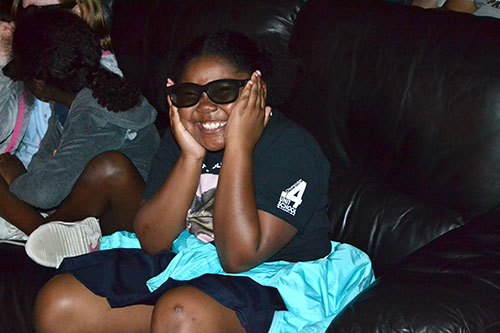 A third grader enjoys a data visualization clip in NCSA’s 3D theater.
A third grader enjoys a data visualization clip in NCSA’s 3D theater.In a fourth fun activity, the youngsters visited NCSA’s 3D studio where, sporting 3D goggles, they checked out films made by the Advanced Visualization Lab using data visualization techniques.
IPA’s campus visit was the culminating event for the 2018–2019 school year, the school’s first year in BESO. Denos shares how the partnership with IPA began. Since around 2013, the program had been in Urbana’s Leal School, which also has a Bilingual program. However, CPLC had wanted to partner with IPA because it is the only local school where the entire school is dedicated to dual language, two way immersion, with a large population of Hispanic kids.
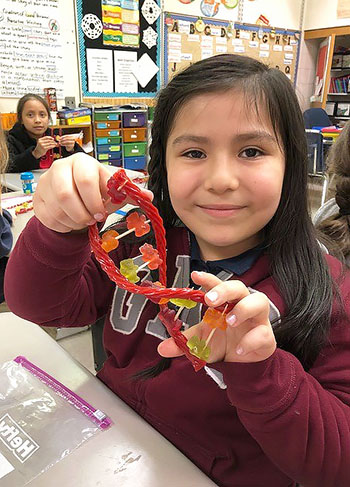 A student exhibits the DNA model that she made during one of the visits to IPA. (Image courtesy of Sharlene Denos.)
A student exhibits the DNA model that she made during one of the visits to IPA. (Image courtesy of Sharlene Denos.) Denos explains that IPA is very diverse, with only about 10–15% white, non Hispanic, and maybe 15% not white, non Hispanics. Latino students are comprised of those who speak English at home and those who speak Spanish at home. The school shoots for an equal population of kids who speak Spanish at home, who sort of teach their peers Spanish, while the other half of the kids speak English at home and are teaching their peers English. “So everybody's improving their languages together, and they work together to do that. And at the end they are supposed to be bilingual and bicultural.”
In addition, CPLC was also intrigued with IPA because they didn't really have any outreach. Being a newer school and not particularly close to the University, there weren’t a lot of university people sending their kids and thus fostering university input.
“We’re the only enrichment program that's coming from the university focused on science,” Denos explains, calling it a “win-win” both for the school and BESO.
So Denos reached out to the school, indicating that CPLC folks wanted to do an outreach that was relevant to what teachers are doing, asking if there was a particular part of the curriculum for which CPLC could serve as a resource.
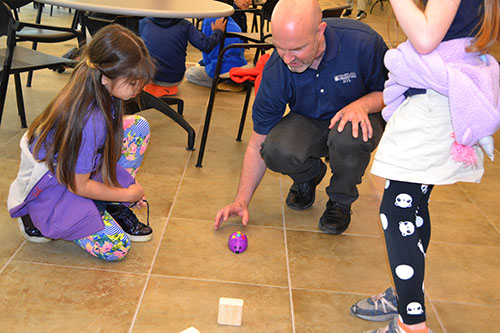 Adam Scott helps students test the programming on their mouse robot.
Adam Scott helps students test the programming on their mouse robot."What we do is very interdisciplinary in the CLC,” she adds. "So we feel like we can connect our work to almost any topic.” So she said, “Okay, what do you need help with?” So when the third grade team wanted some help with the heredity and traits unit, Denos and company figured out how to connect it.
Their goal was to provide activities to supplement the school’s curriculum. “The teachers are very good at what they do,” Denos says. “We don't need to reproduce what they do, right? We want to add to it.” Since the center is focused on developing physics-based quantitative models of the living cell, their goal was to drill down to the molecular basis of that process. That's how they came up activities communicating basic concepts related to the DNA theme: “DNA is a molecule that carries these things called genes, and the genes are what allow you to pass on traits. It’s really simple, right?” She adds that DNA works like a code producing specific patterns. “Then your cell can read that code and then produce the characteristic,” she explains.
So many of the activities, both during the school year and at the campus visit, emphasized computational approaches, and the concept that DNA produces code or instructions, and the way the instructions work.
 IPA student working on her DNA model.
IPA student working on her DNA model.During spring 2019, CPLC volunteers did three different activities at IPA, which were done all in Spanish. According to Denos, this was "really challenging for our volunteers because even though they're native speakers, their scientific training was not in Spanish!”
One school activity, led by Andres Arango, emphasized 3D visualization developed by one of CPLC’s computational labs. Chemla reports, “They create these really nice animations where you can see these molecules come to life, and it really kind of brings home the message of how these molecules work.”
So for this activity, the kids got to wear virtual reality goggles and explore the DNA structure via a virtual reality movie. Then they got to make it. Using gummy bears and licorice, the kids built DNA models for which they could only pair the blue one with the light blue one, or the dark red one with the light red one. And of course, once they finished their model, they got to eat it!
 Mayisha Zeb Nakib helps IPA students program their Dash robot.
Mayisha Zeb Nakib helps IPA students program their Dash robot.In the second activity, led by Luis de Jesus Astacio, a Biological Physics grad student, he explained that to work with DNA, researchers have to extract the DNA from the cell. To illustrate this, he had students extract DNA from strawberries using basic household materials: a solution of salt water and dish detergent to break apart the cell membrane, which lets all the cell contents, such as the protein, come out. Next the students used a protease, an enzyme that breaks protein up into little pieces so it can be gotten rid of. So the students sprinkled on something from the kitchen cabinet—meat tenderizer in in order to break apart the proteins. Last, they isolated the DNA and cause all the strands to clump together (called a precipitation reaction) so the kids could actually see DNA, which is only a nano meter wide, with the naked eye.
“But if lots and lots and lots of them come together,” Denos explains, “then you start getting something where you can see it with your bare eye.” So the students added rubbing alcohol, which caused two layers to form: a water layer and an alcohol layer. The DNA would precipitate into the alcohol layer and then the students could take that out. They put it into the little tube, which they could then wear as a necklace or a bracelet.
In fact, students received an instruction sheet in Spanish for them or some member of their family to actually do it at home with their own cheek cells. Denos says several students were very excited and told her, “’I'm going to do this at home!’
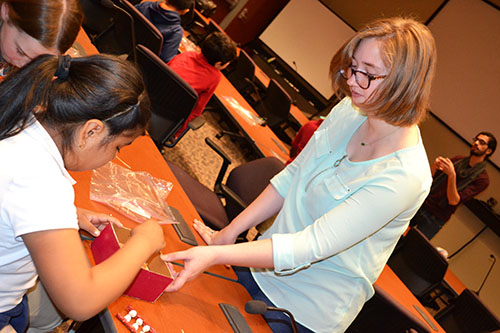 Ashley Knoerdel.
Ashley Knoerdel.Luis Miguel de Jesús Astacio the Physics Ph.D. student who led the extracting-DNA-from- strawberries activity in Spanish, shares why he got involved in the outreach: “My mom taught me the importance and value of helping others early in my life,” he reports. “Since high school, this desire coalesced primarily around STEM and academia-related outreach events and mentoring programs.""
A CPLC Fellow, Astacio, during interactions with Sharlene Denos, discovered that the two shared a passion for outreach and inclusive education. So, tapping in to all he’d gained working with other outreach groups, including PGSA (Physics Graduate Student Association), ENVISION (ENgineers Volunteering In STEM EducatION) and SACNAS (?), he reports, “Combining the human, material and intellectual resources from these groups with Sharlene's expertise and resources as Associate Director for Education and Inclusivity of CPLC, we formed what is now called the BESO program.”
Also helping students extract DNA from strawberries was Ashley Knoerdel, who shares why she got involved in the project. “I'm a CPLC student, and outreach is something that I'm really interested in. I never really had outreach opportunities whenever I was in elementary school and middle school. So seeing these kids really excited was a great opportunity for me cause it's like, ‘Yes, I'm doing something good!’”
The last school activity was led by two astrophysics undergraduates: Lena Flores, a native Spanish speaker from this area, and Jose Sarah, was a lesson on size and scale. The lesson looked at big things, such as astronomical objects are astronomical distances away, vs. how impossibly small a DNA molecule is.
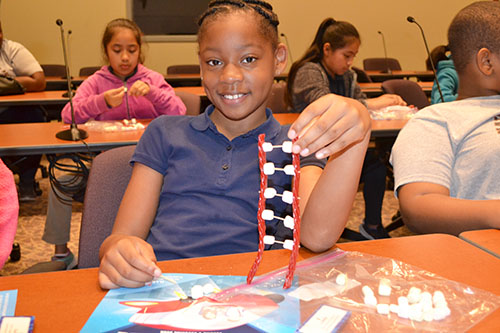 IPA student showing off the DNA model that she made during one of the activities.
IPA student showing off the DNA model that she made during one of the activities. “It's really hard for kids to get their minds around that,” Denos explains. So they had the students do an activity thinking about the distance from the earth to the moon if they were the size of the tip of a pencil. “So you basically squish a meter down to a millimeter,” she explained, then were to measure a piece of string that would represent how far the distance would be. “Of course, no one got anywhere near close,” she says. The idea of the activity was “just to give them a sense that, ‘Wow, that's really far! That's a really big number!’” The goal was to get them started thinking about going the other way—how small a DNA molecule is. So they had kids use CPLC’s scope cam that can be projected onto a screen. Then they asked for volunteers to come up and they just stick it on their face to see pores or individual hairs or they would stick it on their clothes and see the little fibers. Then they peeled the outside layer off an onion so they could see onion cells.
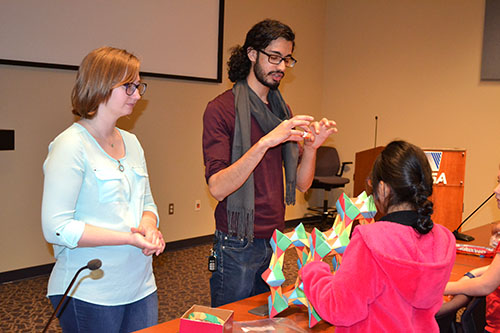 Ashley Knoerdel and Adnan Choudhary interact with third graders.
Ashley Knoerdel and Adnan Choudhary interact with third graders.“So that was kind of a cool thing that they could play around with, you know, exploring the other direction,” she explains, adding, “But it's impossible to see DNA even with this microscope. and it's magnifying things 140 times, but you're still nowhere close to being able to see DNA. In fact, you can't see DNA at all with even the most powerful, best light microscope out there.”
“So you have to get creative and think about other techniques that you can use,” she adds. She explains that at CPLC they use super resolution microscopy Using optical imaging.” So now we can actually see things like DNA, right?”
One reason NCSA was chosen was because of its 3D theater, but also to highlight the computational aspect of the research. Denos explains that when kids think of scientists, they think of people in lab coats working with test tubes, and "they don't realize all the really cool computational and theoretical research that's happening. And so we wanted to highlight that and also use it as a segue to say, recoding these fun robots.
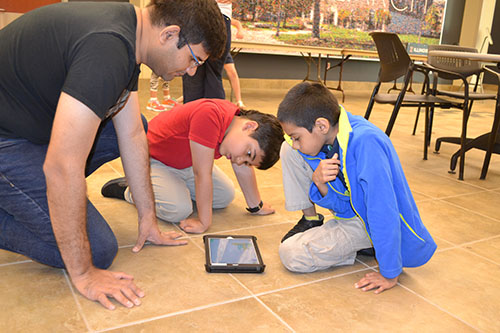 Mayank Boob helps IPA students program their Dash Robot.
Mayank Boob helps IPA students program their Dash Robot. A number of CPLC folks volunteered at the event. For instance, Mayank Boob, a third year Biophysics PhD student shares why he got get involved with the outreach. “It’s summer. I just think it's a fun thing to do, to take a break from the research and also to put things in perspective. It generally feels good to be able to contribute and to pass on the knowledge and whatever we have learned.”
Plus, he got something out of it too: “Obviously, it's always fun to talk to kids and to try and tell them something interesting...They're always very enthusiastic, so it helps to drive your own creativity.”
Also helping out was Ashley Knoerdel, a first year biophysics graduate student. She reports that bringing kids onto campus to events like this “gets them excited about science that they might not have learned about in class, and it gets them into a place where they can be like, ‘Oh, I fit here!’”
She reports that during the school’s visit the students “definitely seemed engaged, and I think that the impact that we had was exciting them more about simulations and coding, and getting them excited about what computers can do and what we can do with computers.”
Coming from a small school to a big university, she herself had felt overwhelmed and told herself, “There's so much going on here. What do I do?” So she believes campus visits help youngsters “kind of get used to it and they feel like it's someplace that they can be rather than someplace they have to figure out how to fit in.”
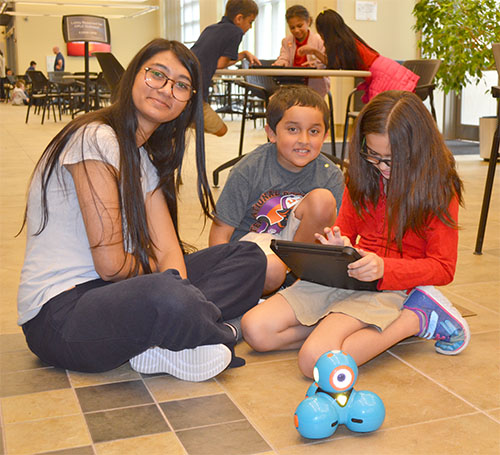 Mayisha Zeb Nakib.
Mayisha Zeb Nakib.Helping at the outreach with a robot activity was Andres Arango, a PHD student in biophysics, who also visited IPA to teach the DNA gummies activity and a virtual reality headsets activity. He believes the main benefit of outreach is that students are: “exposed to science that they wouldn't be exposed to normally. And they also see people like them, and it gives them hope. It hopefully inspires them to want to pursue a career in science, engineering, mathematics, STEM in general.”
Arango found it rewarding to expose today’s kids to activities he hadn’t experienced as a youngster. “When I was a kid, I didn't have things like this, so I would have loved to have seen this.” He also appreciates the programs bilingual component. “When I speak Spanish with them, it makes them realize that maybe they can also go into biophysics or physics or engineering. I've actually heard some of them say things like, ‘I want to be an engineer. I want to do this!’ and it's awesome.”
Arango adds that whenever he presents, he shows the kids a picture of himself when he was little, playing with his science things. His goal in doing outreach is to “expose them to science early on so they can start getting ready now. Because as you know, it only gets harder the older you get.” He adds that a lot of jobs in the future are going to require coding, and says “This robot activity is really going to expose them.”
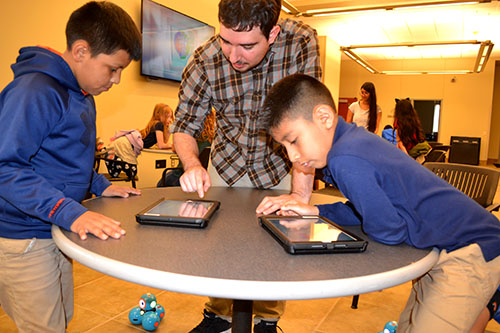 Andres Arango (center) interacts with students who are programming their Dash Robot.
Andres Arango (center) interacts with students who are programming their Dash Robot. Because IPA is one of the only schools in Champaign that doesn't have a science night, Denos is also looking forward to helping get one started, with the goal of including family. “Because today we had a couple parents,” she explains, regarding the May 16th outreach event, “but we really would like to do something that includes the whole family, little brothers, grandmas, uncles, aunts, you know, anybody.”
Story and photographs by Elizabeth Innes, Communications Specialist, I-STEM Education Initiative.
More: K-6 Outreach, CPLC, STEM Pipeline, Underserved Students/Minorities in STEM, 2019
For additional related I-STEM articles, see:
- Cena Y Ciencias Exposes Hispanic Elementary School Students to Materials Science at MRL
- Myong, BioE Undergrads Expose Middle Schoolers to DNA/Cell Measurement
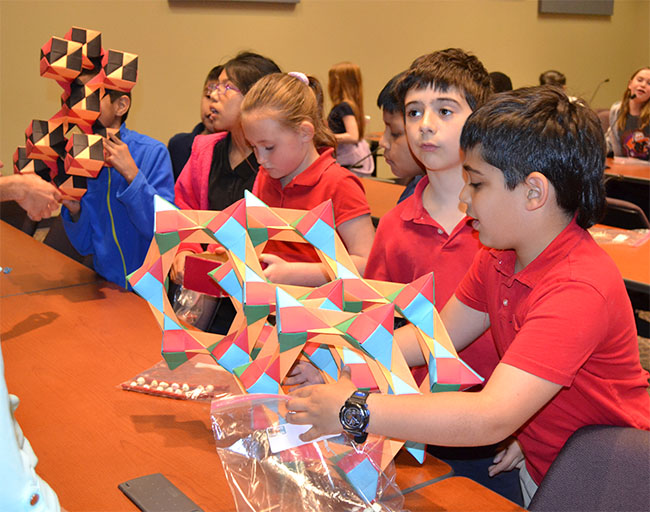 Students examine DNA origami.
Students examine DNA origami.












.jpg)
















